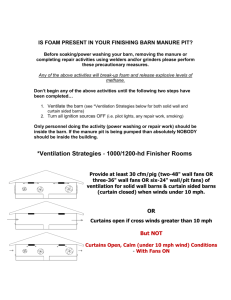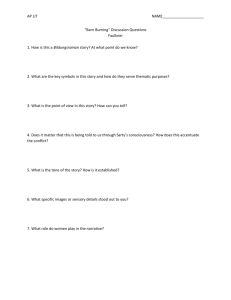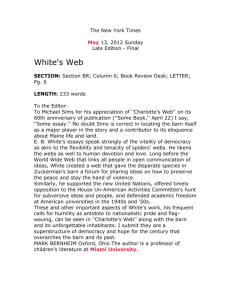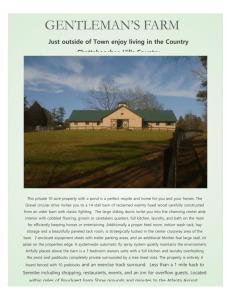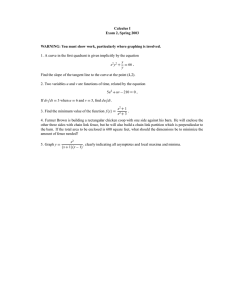Ventilation and Heat Stress
advertisement
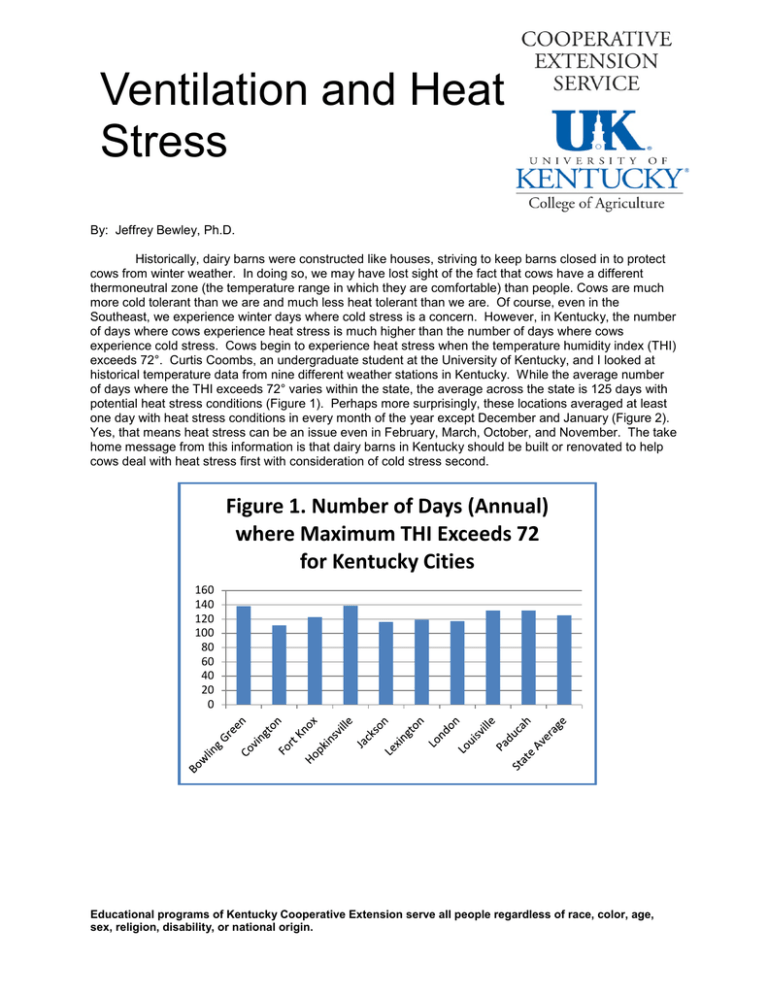
Ventilation and Heat Stress By: Jeffrey Bewley, Ph.D. Historically, dairy barns were constructed like houses, striving to keep barns closed in to protect cows from winter weather. In doing so, we may have lost sight of the fact that cows have a different thermoneutral zone (the temperature range in which they are comfortable) than people. Cows are much more cold tolerant than we are and much less heat tolerant than we are. Of course, even in the Southeast, we experience winter days where cold stress is a concern. However, in Kentucky, the number of days where cows experience heat stress is much higher than the number of days where cows experience cold stress. Cows begin to experience heat stress when the temperature humidity index (THI) exceeds 72°. Curtis Coombs, an undergraduate student at the University of Kentucky, and I looked at historical temperature data from nine different weather stations in Kentucky. While the average number of days where the THI exceeds 72° varies within the state, the average across the state is 125 days with potential heat stress conditions (Figure 1). Perhaps more surprisingly, these locations averaged at least one day with heat stress conditions in every month of the year except December and January (Figure 2). Yes, that means heat stress can be an issue even in February, March, October, and November. The take home message from this information is that dairy barns in Kentucky should be built or renovated to help cows deal with heat stress first with consideration of cold stress second. Figure 1. Number of Days (Annual) where Maximum THI Exceeds 72 for Kentucky Cities 160 140 120 100 80 60 40 20 0 Educational programs of Kentucky Cooperative Extension serve all people regardless of race, color, age, sex, religion, disability, or national origin. Ventilation and Heat Stress Figure 2. Number of Days where Maximum THI Exceeds 72 by Month for Kentucky Cities 0 Jan. Feb. Mar. Apr. May Jun. Jul. Aug. Sep. Oct. Nov. Dec. Bowling Green Covington Fort Knox Hopkinsville Jackson Lexington London Louisville Paducah During warmer temperatures, poor ventilation may result in cows expressing obvious signs of heat stress (i.e. breathing heavily, panting). Research has illustrated that average lying time decreased from 10.9 to 7.9 hours per day as temperature increased. Thus, even stall usage may be altered if barns are inadequately ventilated. When temperatures are cooler, poor ventilation can result in increased respiratory problems and transmission of other diseases. Lack of proper ventilation can lead to high moisture levels, manure gases, pathogens, and dust concentrations which create an adverse environment for dairy cows. For optimal production and well-being, dairy cows should be provided with a constant supply of fresh, clean air. Frequently exchanging air removes or reduces the concentrations of dust, gases, odors, airborne disease organisms, and moisture. Maximizing natural ventilation is the first step toward improving ventilation. Natural ventilation relies on barn openings and orientation to remove heat and humidity from the animal’s environment. Exhausted air generally leaves the barn through sidewalls and ridge openings. Although old barn designs suggested closed-in barns, current recommendations are to open the barns up to allow for better air exchange. Sidewalls allow for air, heat and humidity to be easily and continuously removed from the barn. This is particularly critical during the summer. If producers are concerned about the potential negative effects of open sidewalls during the winter, sidewall curtains, which can be raised in the summer and lowered during the winter, may be added to eliminate this concern. A ridge opening should also be provided at the top of the building to facilitate air removal through the top of the barn. Warm, moist air rises and exits through the ridge opening even on calm days. The steeper the roof slope the better the movement of the warm moist air out of the ridge vent. The roof slope should be at least 3/12, 3 inches of rise for every 12 inches of run. A slope of 4/12 is preferred. The ridge opening should be at least 2 inches for each 10 feet of building width. With overshot roofs, this opening should be at least 3 inches per 10 feet of building width. Producers are often resistant to this change because of fears of precipitation entering the barn through the ridge opening. Although this is generally not a major problem, a ridge cap may be added to eliminate this concern. A few weeks ago, I visited a producer in western Kentucky who had constructed a new barn with an open ridge vent. He suggested that he was considering opening the ridge vent in his older freestall barn because he was so pleased with how the cows responded to the new barn. He recognized that he could see dramatic improvements in cow comfort in his old barn without spending a lot of money. Many Kentucky barns and cows could benefit from this type of renovation. For many older barns with ventilation issues, the main opportunity for improvement is removing tin or wood sidewalls that block natural winds from entering the barn. Before removing these obstructions, consider how this change might affect the structural integrity of the building. Strive for at least 8 feet of sidewall opening. A 3 to 4 foot overhang should be provided to prevent precipitation from entering the barn. Curtains may be needed to block adverse weather during the winter. Similarly, Educational programs of Kentucky Cooperative Extension serve all people regardless of race, color, age, sex, religion, disability, or national origin. Ventilation and Heat Stress opening the endwalls may also prove beneficial. In some cases, there may be benefit in raising the height of the roof to increase the amount of air flowing through the sidewalls. Adding or increasing the size of the ridge opening can dramatically improve natural ventilation. Natural ventilation can also be supplemented with mechanical ventilation with the addition of fans. Adding fans to an existing freestall barn is one of the highest return investments a dairy producer can make. Figure 3. Barns that are completely enclosed do not allow for adequate air exchange resulting in a damp, dark environment and can lead to heat stress, respiratory problems, and increased transmission of disease. Figure 4. The ideal freestall barn maximizes natural ventilation with high, open sidewalls, a ridge vent opening and supplements natural ventilation with fans used to increase air flow and exchange. Educational programs of Kentucky Cooperative Extension serve all people regardless of race, color, age, sex, religion, disability, or national origin.
